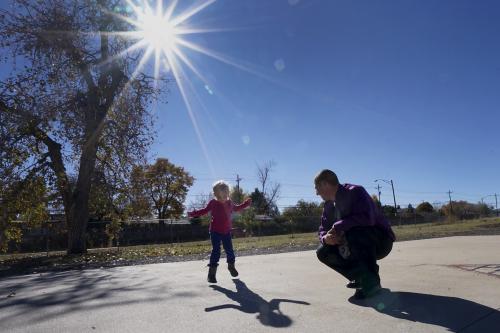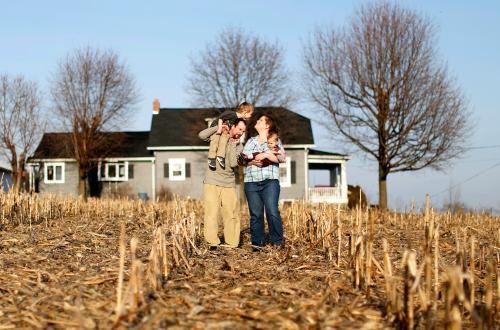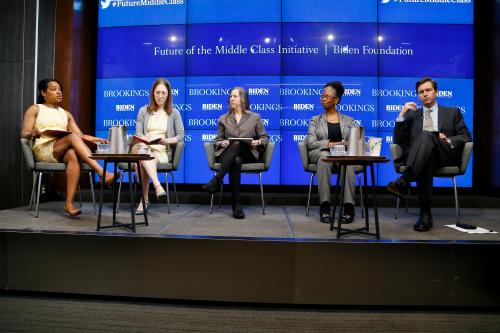This summer, the Future of the Middle Class Initiative at Brookings published a paper and interactive on the near-innumerable ways experts have defined the middle class. In part, we simply wanted to catalogue these definitions, and to bring to light the normative aims that might motivate them. But our other purpose was to consider possible definitions for our work moving forward. As we wrote in the paper,
It is difficult to describe the condition and challenges of the middle class without some clarity about who comprises the group in question. The crucial questions we need to answer are: why are we analyzing the middle class and its shifting fortunes, what are the main challenges they face, and how can the quality of life of the middle class be improved? All of this requires a reasonably clear idea of who we are talking about.
Today, we published our definition of the “middle class”: The middle 60 percent of households on the income distribution. This captures the 30 percent of households above and below median income, with incomes ranging from $37,000 all the way to $147,000 for a three-person household (or its equivalent), according to the latest data from the CBO:

The Initiative’s definition page describes what we mean by income (pre-tax, pre-transfer income) and how we adjust for household size (the square root scale). Here, however, we want to tell the story of how we arrived at this definition, from the decision to focus on income instead of, say, educational attainment, to the selection of the wide range of households in the middle 60 percent.
As with all summer romances, it is a story best told through our brief flings with near-misses. Here are the definitions we courted before we fell for the middle 60:
Honorable mention: Educational attainment
Intuitively, we tend to think about social class in terms of lifestyle, not money. One colleague of ours saw an Instagram post that quipped that every middle-class family has one fridge in the kitchen and a second in the garage. Another colleague suggested that being middle class is about having a tree in the front yard—and by extension, owning a home. Even the U.S. Department of Commerce has waxed poetic about middle-class aspirations. (We jest, but we liked this definition enough to quote it at length in our own report.)
But what is a social scientist to do with fridges and aspirations? We need to express social class in terms we can measure.
Sociologists often consider social class to be a matter of one’s occupation or education—proxies for the respect one commands in society and the agency one has in it. One advantage of these measures over income is that they tend to be consistent over the life course. Job loss could mean that a family is middle-income one year and low-income the next, but they may still be part of the middle class according to an education-based definition. (We prefer education over occupation because it’s easier to rank educational credentials than it is to rank occupations across industries.)
The challenge is in determining what level of education counts as middle class. Does the middle class include all those without bachelor’s degrees? Or, rather, is a bachelor’s degree required?
Several experts have defined the middle and/or working classes using a combination of education and income. Our own Isabel Sawhill defines the group she calls “the forgotten Americans” as working-age adults without four-year college degrees whose family incomes are in the bottom half of the income distribution. Joan Williams and Heather Boushey identify the “missing middle” as households that are between the bottom third and top fifth of household income, plus households in the top income quintile in which no adult has a bachelor’s degree. And an Opportunity America/AEI/Brookings working group defines the working class as those with household incomes between the 20th and 50th percentiles who have a high school education but no college degree.
We diverge from our respected colleagues’ definitions at our own peril—but we ultimately abandoned an education component, for two reason. One is that we would like to find out what level of education affords middle-class status, and we can’t do that if we’ve set the answer into our definition. Another is that we don’t know how well an education-based definition will hold up over time. Perhaps bachelor’s degrees will soon supplant high school degrees as the ticket to the middle class. Perhaps they already have.
Second runner-up: Median income
We return, then, to the tree in the yard and the fridge in the garage. At heart, these colloquialisms are about what the middle class can afford, whether that takes a high school degree or a master’s. This suggests that the middle class should be defined by its resources, which we operationalize as income.
Income-based definitions can be absolute or relative. An absolute definition would identify the middle class according to an absolute standard of living—for instance, above some multiple of the poverty threshold—that doesn’t increase as a society gets richer in real terms. A relative definition is agnostic about what counts as a middle-class standard of living: it simply identifies the middle of the income distribution, wherever that distribution happens lie at a given time.
We decided early on to use a relative definition, in large part because people tend to evaluate their status not in absolute terms, but relative to those around them. Of course, if we were interested solely in relative measures of well-being, then universal income growth would not appear to improve the middle class’s quality of life. They would be in the same spot relative to everyone else—which is clearly nonsense. It’s still necessary to evaluate trends in absolute income for our relative group.
One popular relative measure defines the middle class within bounds around median income. Pew Research Center, for instance, places the middle-class incomes between two-thirds and double the median. We’ve also seen 75 to 125 percent median income, 50 to 150 percent, and so on. The options are endless.
These definitions allow the middle class to grow or shrink as people move up and down the income ladder. They primarily tell us about income polarization: in general, the smaller the middle class, the more spread there is in the distribution. Importantly, a shrinking middle class isn’t synonymous with national decline. In fact, Pew finds that the middle class is shrinking primarily because more people are entering the upper class (though the lower class has also expanded).
There’s something appealing about trying to “grow the middle class.” But median-based definitions make it difficult to compare income shares across classes, since the middle class is changing in size. If the middle class is receiving a smaller share of income but also contains a smaller share of people, is the middle class better off, worse off, or the same as before?
Our actual mission is not to grow the middle class, but to improve its prospects. And so we decided that our middle class should represent a constant share of the population.
First runner-up: 20th to 60th percentiles of income
In previous work with Camille Busette, one of us has previously defined the middle class as the 20th to 60th percentiles of income—that is, the second and third quintiles, with incomes ranging from about $37,000 to $95,000 for a household of three. As we wrote in that paper, one reason to focus on this 40 percent of the population is that this group has seen the slowest income growth in recent decades:
We initially chose to focus on the 20th to 60th percentiles because they are the “struggling middle”: they are not quite low-income, but nor are they financially comfortable. And these quintiles are losing ground. Consider the change in each quintile’s share of income after taxes and transfers from 1979 to 2014:
As the charts above show, though, the fourth quintile has more in common with the bottom three quintiles than with the top quintile: it has experienced slow income growth and has a smaller share of income now than in 1979. If the fourth quintile is neither upper nor middle class, then what is it?
There is also the issue of symmetry. The 20th to 60th percentiles give us a middle class that is asymmetric around the median, meaning that the middle class is not actually in the middle. As some of our colleagues pointed out, this group more closely resembles the so-called “working class.”
Winner: 20th to 80th percentiles of income
We have decided, then, to include the fourth quintile in our middle class. This means that for a household of three, middle-class incomes range from $37,000 to $147,000. For us, this definition has six advantages. It is:
- precise;
- relative;
- a measure of resources;
- a constant share of households;
- symmetric around the median; and
- broad enough to capture the identity of the American middle class.
This definition highlights the middle class’s declining share of income. The middle 60 percent of American households earned half of all income before transfers and taxes in 1979 but only 40 percent in 2014, with the entirety of the difference going to the top 20 percent. Transfers and taxes have reduced but not reversed the decline in middle-class income shares in favor of the top 20 percent:
Friends and colleagues have rightly asked whether we think a household earning $40,000 is equivalent to a household earning $140,000. The answer, of course, is no. The middle 60 percent covers an enormous range of households, and those at the upper and lower thresholds will have vastly different experiences.
But what these two extremes have in common is that they could both reasonably be considered (and are likely to consider themselves) part of the middle class. Pew has shown that even a majority of those with incomes over $100,000 identify as middle class. For those confronting pricy urban housing markets, $100,000 may seem like a middle-class income indeed.
As one of us wrote in 2016, “In America—where almost everyone is middle class—the distinctions that matter are within that broad category.” So instead of trying to change America’s idea of what it means to be middle class, we have chosen to embrace the breadth of middle-class identity, and to always acknowledge and examine the considerable variations within it.







Commentary
There are many definitions of “middle class”—here’s ours
September 4, 2018
Richard V. Reeves and Katherine Guyot explain why the Future of the Middle Class Initiative defines the middle class as the middle 60 percent of households on the income distribution.